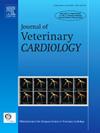心电图诊断为心室预激的猫的临床、心电图和诊断成像特征及预后:23 例病例的回顾性研究(2010-2022 年)
IF 1.3
2区 农林科学
Q2 VETERINARY SCIENCES
引用次数: 0
摘要
导言/目的当心房电冲动通过称为辅助通路(AP)的异常肌束过早兴奋心室时,就会发生室性预激(VPE)。正交性房室往复性心动过速是一种再发的窄复律室上性心动过速(SVT),通过 AP 上的逆行传导维持。本研究旨在描述心电图诊断为 VPE 的猫的患者信号、临床症状、心电图(ECG)和诊断成像特征、治疗方法、预后变量和预后情况。材料和方法这是一项多中心回顾性研究,研究对象为 2010 年 1 月至 2022 年 8 月期间诊断为 VPE 的 23 只猫。室性心动过速的诊断依据是心电图显示的 PR 间期缩短、三角波和 QRS 间期延长。中位生存时间(MST)由卡普兰-梅耶曲线估算得出。结果14只(60.8%)患有VPE的猫在心电图上也记录有SVT,其中7只在心电图上确认为正交性房室往复性心动过速。根据相关临床症状,有 4 只(17.4%)猫被怀疑患有 AP 介导的快速性心律失常。常见症状包括昏厥(15/23;65.2%)和呼吸困难(14/23;60.8%)。五只猫(21.7%)无症状。SVT 期间的心率范围为 310 至 420 bpm(中位数:375 bpm)。初始治疗包括阿替洛尔(10/18)、索他洛尔(5/18)、地尔硫卓(2/18)和胺碘酮(1/18)。结论大多数 VPE 猫都有 SVT 症状。患有 VPE 的猫的预后良好,MST 超过 5 年。本文章由计算机程序翻译,如有差异,请以英文原文为准。
Clinical, electrocardiographic, and diagnostic imaging features and outcomes in cats with electrocardiographic diagnosis of ventricular pre-excitation: a retrospective study of 23 cases (2010–2022)
Introduction/Objectives
Ventricular pre-excitation (VPE) occurs when atrial electrical impulses prematurely excite the ventricles through an aberrant muscle bundle known as an accessory pathway (AP). Orthodromic atrioventricular reciprocating tachycardia is a re-entrant, narrow complex supraventricular tachycardia (SVT), maintained through retrograde conduction over an AP. The study aimed to describe patient signalments, clinical signs, electrocardiographic (ECG) and diagnostic imaging features, treatments, prognostic variables, and outcomes in cats with ECG diagnosis of VPE.
Animals
Twenty-three cats diagnosed with VPE between January 2010 and August 2022 were included in this study.
Materials and Methods
This was a multicenter, retrospective study with twenty-three cats diagnosed with VPE between January 2010 and August 2022. Ventricular pre-excitation diagnosis was based on ECG evidence of shortened PR interval, delta wave, and prolonged QRS duration. The median survival time (MST) was estimated by the Kaplan-Meier curve. Log-rank tests were performed to assess for an association between clinical signs or presence of structural heart disease on the MST.
Results
Fourteen (60.8%) cats with VPE also had SVT documented on ECG, with 7 of 14 with ECG confirmation of orthodromic atrioventricular reciprocating tachycardia. Four (17.4%) cats had suspected AP-mediated tachyarrhythmia based on associated clinical signs. Common presenting signs included collapse (15/23; 65.2%) and respiratory distress (14/23; 60.8%). Five (21.7%) cats were asymptomatic. Heart rate during SVT ranged from 310 to 420 bpm (median: 375 bpm). Initial treatment included atenolol (10/18), sotalol (5/18), diltiazem (2/18), and amiodarone (1/18). From the date of diagnosis, MST was 1872 days (5.1 years).
Conclusions
The majority of cats with VPE also had symptomatic SVT. The prognosis for cats with VPE is considered good with an MST of greater than five years.
求助全文
通过发布文献求助,成功后即可免费获取论文全文。
去求助
来源期刊

Journal of Veterinary Cardiology
VETERINARY SCIENCES-
CiteScore
2.50
自引率
25.00%
发文量
66
审稿时长
154 days
期刊介绍:
The mission of the Journal of Veterinary Cardiology is to publish peer-reviewed reports of the highest quality that promote greater understanding of cardiovascular disease, and enhance the health and well being of animals and humans. The Journal of Veterinary Cardiology publishes original contributions involving research and clinical practice that include prospective and retrospective studies, clinical trials, epidemiology, observational studies, and advances in applied and basic research.
The Journal invites submission of original manuscripts. Specific content areas of interest include heart failure, arrhythmias, congenital heart disease, cardiovascular medicine, surgery, hypertension, health outcomes research, diagnostic imaging, interventional techniques, genetics, molecular cardiology, and cardiovascular pathology, pharmacology, and toxicology.
 求助内容:
求助内容: 应助结果提醒方式:
应助结果提醒方式:


